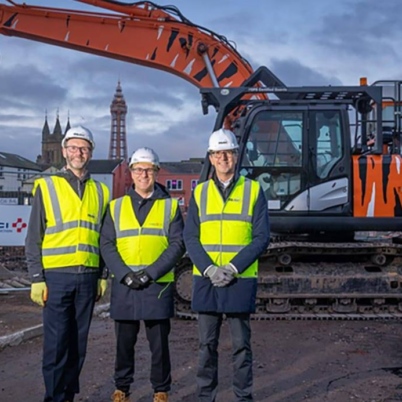
- News
- United Kingdom
Work begins on transformational civil service office site in Blackpool town centre
Work has started on a new office building, which forms part of the place-changing £350m Talbot Gateway regeneration that is transforming the heart of Blackpool town centre.
VINCI Building, Nationwide placemaker, Muse, and its partner, Blackpool Council, have started work bringing forward a 215,000sq ft highly-sustainable office building for the civil service.
More than 3,000 public servants will relocate to the striking, seven-storey regional hub, when it completes in 2025.
The new offices will generate significant new footfall to the area, boosting trade to local businesses, retailers, restaurants, cafes and leisure facilities, alongside a wealth of new job opportunities for local people.
Alan McBride, projects director at Muse, said: “We’re pleased to appoint VINCI Building and to start on site building this fantastic facility on behalf of Blackpool Council.
“As a business, we’re committed to creating places with purpose for people that offer tangible environmental and social benefits to local communities and are looking forward to seeing the building progress.
“We’re focused with partners as we re-energise the town centre, by delivering a place that blends the town’s rich history with its aspirations for the future. We’re delighted to be playing such an important role with the council in delivering our shared vision for building a better, more attractive and resilient Blackpool”
Cllr Lynn Williams, Leader of Blackpool Council, said: “It is fantastic to see this development start on site and is a great start to the New Year. Throughout the pandemic we were determined to push on with our regeneration of Blackpool and it is really exciting to see so much of our vision for the future coming to fruition.
“This physical generation for the future of our town is critical, but most importantly it means more jobs for local people and more money in local people’s pockets through a huge increase in footfall and spend in our town centre.
“This is the third phase of the Talbot Gateway development we have now delivered in partnership with Muse and we are pleased to welcome VINCI Building to that partnership and are looking forward to working with them and the social value benefits they can bring to our town through this contract.
“Jobs for local residents and spend in our local economy are key components of our town regeneration as that will build a sustainable future for generations to come. I am delighted that this new office development will start to take shape in the months ahead and in the most sustainable way possible, all helping to make Blackpool a better place to live and work.”
Gary Bowker, regional managing director at VINCI Building, said: “VINCI Building are so pleased to be involved in the exciting regeneration of Blackpool town centre. The development of such a significant Grade A office in the town centre will significantly increase daytime footfall once completed and will undoubtedly benefit local businesses over the long term. Low energy and low carbon design and material choice has been at the heart of decision making and this will result in a truly energy efficient, low carbon building that we can all be proud of. It has been a real team effort through the pre-construction phase, and we look forward to this continuing on to site.”
The new building has been designed by renowned architects, Make, to BREEAM “Excellent” standard, which means it will operate on low energy and promote both sustainable development and wellbeing.
An inclusive approach to sustainability was taken from the outset to make sure the building will be as energy-efficient as possible, with high levels of insulation and air source heat pumps to provide low-carbon heating and cooling. Demand-driven ventilation will improve indoor air quality, while at the same time allowing energy savings during times when the building is not occupied.
During the building’s inception, partners completed early-stage whole life and upfront embodied carbon assessments, to eliminate inefficiencies where possible and reduce the building’s whole carbon footprint. This results in the new offices aiming to reduce its upfront embodied carbon intensity to 800 kgCO2e/m2. compared with 1100kgCO2e/m2 for a typical office development.
